How To Write A Memoir 101 – Tell Your Life Story
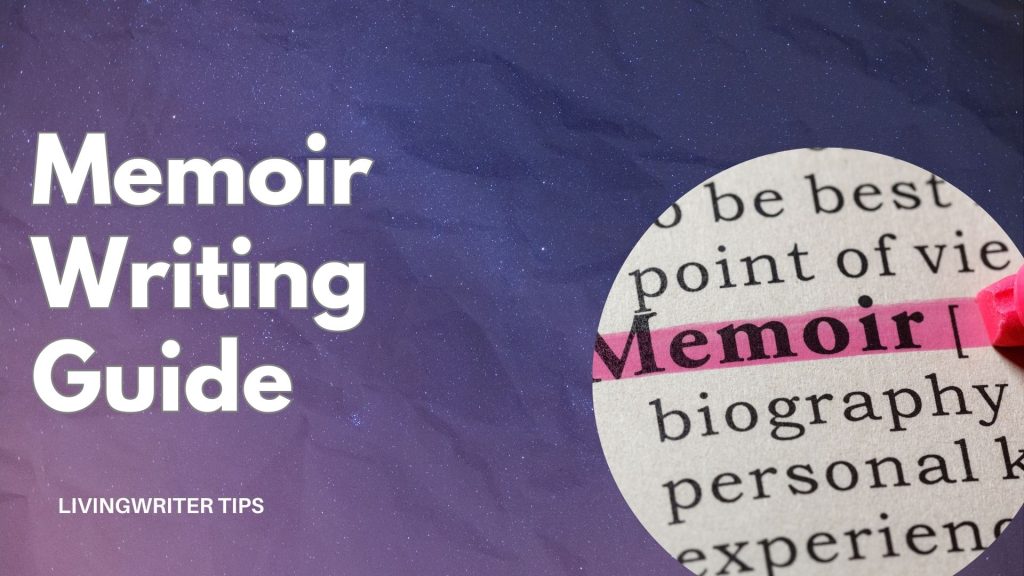
Many people have thought about writing their life story into a book. People want to tell their stories because storytelling is a part of human nature, and no story is more personal to us than our own. That said, it’s hard to know where to start and how to finish your life story in a way people want to read. Today, I’ll be covering everything you need to know about how to write a memoir of your life.
To write a good memoir, you’ll need to figure out which parts of your life are most important to the story your telling, organize them, and then write them in a structured way that is entertaining and egaging to readers from start to finish, just like you would a novel.
Yep. Unfortunately, there is no way around solid writing, even when you’re writing a book about your own life. But don’t worry; I’ll give you the tips for success. I’ll cover how to know if your story is interesting enough to be a memoir, how to navigate sensitive family issues when writing, and finally, five books I recommend you read if you want to write a memoir. So, let’s get started.
Table of Contents
What Is A Memoir?
Let’s start with the basics, just so we’re all on the same page. A memoir is autobiographical writing that focuses on a particular aspect of the author’s life. It often explores a specific theme, event, or period and allows you to reflect on your personal experiences and growth. Think of this as a more detailed, zoomed-in look at particular parts of your life.
Memoirs can be written in various styles, from formal and academic to informal and conversational. While they usually don’t tell your entire life from start to finish, they typically aren’t short and can reach full novel length.
Key characteristics of a memoir:
- Personal narrative: Memoirs are deeply personal accounts of your life.
- Focused theme: They often explore a specific theme or event, such as overcoming adversity, finding love, traveling to a new place, grief, etc.
- Reflection and growth: Memoirs allow you to reflect on certain experiences and how they have shaped you.
- Subjective perspective: Memoirs are written from your subjective point of view, offering your unique and personal interpretation of events.
What Is An Autobiography?
An autobiography is a more comprehensive account of your life. It covers all aspects of your life, from childhood to adulthood, and includes all significant events, relationships, and achievements and is written in chronological order.
Autobiographies are usually written in a more formal style than memoirs and aim to provide a complete and more objective telling of your life story from the start to your current point in life.
Key characteristics of an autobiography:
- Comprehensive coverage: Autobiographies give a full look at your entire life, including childhood, education, career, etc.
- Objective tone: While autobiographies are written from your perspective, they often have a more objective and factual tone.
- Chronological order: Autobiographies are typically organized chronologically, following the sequence of the author’s life events.
Autobiography Vs. Biography
While both autobiographies and biographies focus on a person’s life, there are a few key differences. An autobiography is written by the person whose life is being described. So, you’re writing about your own life, while a biography is when someone writes someone else’s life story.
Here are a few other differences between the two that are worth mentioning:
- Perspective: Autobiographies offer a first-person perspective, while biographies provide a third-person perspective.
- Scope: Autobiographies typically cover your entire life, while biographies may focus on a specific aspect or period.
- Objectivity: Biographies are generally more objective than autobiographies, as they are written by someone outside of the subject’s life.
Memoir Vs. Autobiography – Which Should You Write
The key difference is the level of detail and the focus of the narrative. Autobiographies aim to provide a comprehensive overview of one’s life, while memoirs often focus on a more specific theme or series of events.
The choice between the two depends on your circumstances and the story you want to tell. Here are some factors that may influence this choice:
- Scope of experiences: If you have a wide range of interconnected experiences that contribute to a coherent narrative, an autobiography may be the best choice. However, a memoir can be more effective if the focus is on a specific theme or event(s).
- Depth of exploration: Memoirs often allow for a deeper exploration of a particular aspect of your life, while autobiographies provide a broader overview.
- Target audience: The intended audience may also influence the choice between memoir and autobiography. For example, a story aimed at a specific niche audience (say, dealing with personal loss) would do best as a memoir.
For example, Benjamin Franklin’s autobiography is a classic example of a comprehensive life story. He begins with his humble beginnings and tells his rise to prominence as a statesman, scientist, and inventor. The breadth of his experiences and achievements makes it necessary to tell his entire life story to provide a complete picture of his journey.
Elie Wiesel’s memoir “Night” is an account of his experiences in concentration camps during the Holocaust. While it is a deeply personal narrative, it does not require a complete life story to be effective. Instead, it limits the scope to focus on specific experiences and their lasting impact on his life.
How To Write A Memoir
Ok, you’ve decided to turn your life story into a book, specifically a memoir. What now? How do you write a memoir? Well, the short answer is, “Much like you would a novel.” Aside from knowing the plot and the “characters” ahead of time, the goal is the same – Tell your story in an entertaining and engaging way that readers want to read.
I want to mention that many people find great value in writing their stories, even if they never intend to publish, share, or sell them. If that is the case, I 100% encourage you to put pen to paper. And if you’re telling the story for yourself, you can focus a little bit less on the technical side of the craft.
For everyone else, if you want other people to read and enjoy your memoir, it will have to be well-written, well-paced, maintain some tension, and have conflict and resolution, just like a fiction novel would. So, below, I’ll cover these technical aspects as well as how to get your life’s events organized and ready for the page.
How To Start Writing A Memoir?
Many people struggle with where to start telling their stories. The “100 Moments” exercise opens you up and gets your most important ideas out. To do this, you’ll sit down with a pen and paper (I do recommend you physically write these out) and list 100 moments from your life.
To start, set aside 20 to 30 minutes to write. The time frame is important because this is a free-thinking exercise. You kinda want to sit down and write what comes to mind without thinking about it too much. It may take a while to get all 100 down, but you definitely want to set that 30-minute cap so you don’t overthink.
You don’t have to include everything you write on the page in the memoir. This is simply to “mine out” some of the more standout moments. That said, they don’t all have to be huge things. Simple things like smells and vibes are ok, as are incomplete thoughts. However, you do want specific moments whenever possible.
For example, “the smell of my childhood basement” may be something that comes up. And that’s great. If possible, tie it to a memory of being in the basement. That way, if you include it in the book, you’ll have a little bit more to work with.
Is Your Story Good Enough To Be A Great Memoir?
Many wonder if their life is interesting enough for a book. And it’s a good question to ask. After all, most of us aren’t celebrities. And, of course, the things that have happened to you will be most important to you. It’s also common to have support from those close to you… But will strangers find your life as impactful as you do?
I’ve got good and bad news. In general, the telling is more important than the story. If you can write well, even simple things like your happy marriage can be something people want to read. So, yes, your story can likely make a good memoir, regardless of what it is, provided you can write it well.
As mentioned above, your goal is important. If you have no writing experience, it’s going to be a stretch to write a best-seller on your first try. To sell books, you must work on your technical writing and write a good story.
However, the journey is the goal for many people; if it’s important to you, write it regardless. If you don’t care about selling books or even sharing your work, just write the story that you are compelled to tell.
How To Write A Memoir People Want To Read
A memoir is a unique writing experience. Unlike fiction, you don’t need to invent characters or plots. You’ve probably also got some natural progression from beginning to middle and end and some natural conflict. However, you’ve still got to present them in a cohesive, entertaining way.
Here are five things that you’ll want to consider:
1. Story Structure
Story structure dictates how your story unfolds and at what pace. This is crucial for keeping your reader engaged throughout the story. As I said, memoirs aren’t short works, and it can take hours upon hours for a reader to finish your book. A well-paced story will maintain tension and keep them reading, while a lack of structure means they likely won’t finish the book.
The Three-Act Structure
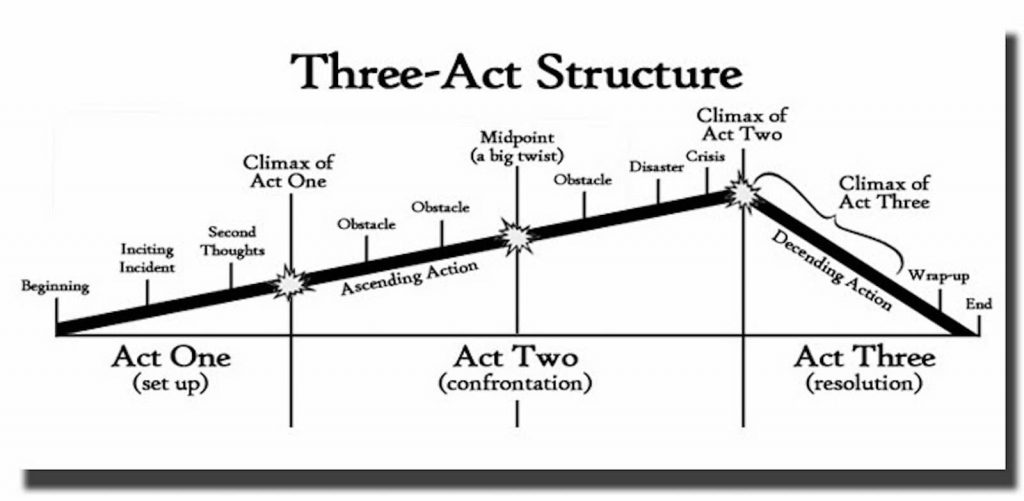
The three-act structure is probably the most common storytelling framework and is used in various forms of media, including novels, plays, and films. It divides a story into three main parts:
- Act I: Setup
- Introduces the main characters and their world.
- Establishes the initial conflict or problem.
- Sets up the story’s stakes and goals.
- Act II: Rising Action
- The conflict intensifies, and the stakes are raised.
- Characters face obstacles and challenges.
- The story builds towards a climax.
- Act III: Falling Action and Resolution
- The climax occurs, resolving the main conflict.
- The characters face the consequences of their actions.
- The story concludes with a sense of closure.
While this is a general outline, the three-act structure can be adapted to fit your memoir’s unique story and themes. The key is to ensure that the narrative has a clear beginning, middle, and end and that the conflict and character development are well-structured.
For a deeper dive into the three-act structure, click here: Screenplay Structure: Tips to Engage Audiences.
LivingWriter Outlines
Perhaps the easiest way to outline your memoir is to write with LivingWriter. There are devoted outlines for memoirs, including several subgenres.

This outline will apply the three-act structure mentioned above directly to your manuscript, which you will then fill in with your chapters.
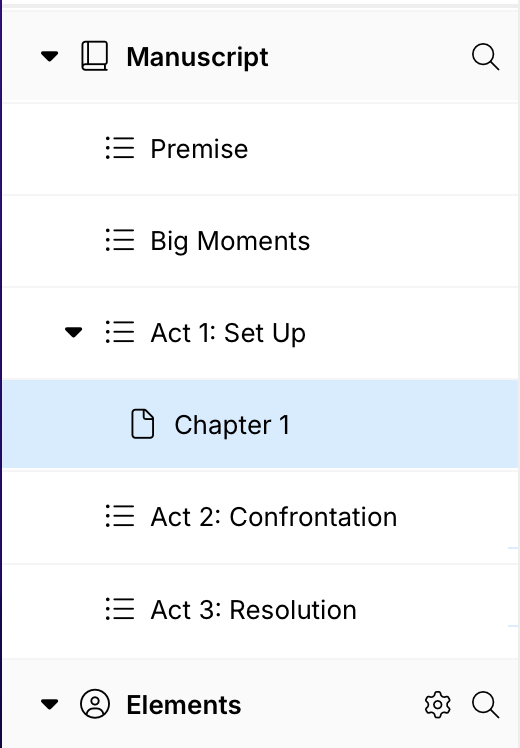
AI Outlines
However, you can take things a step farther, and use a LivingWriter AI Outline too. An AI outlines give you a complete framework to build your story within. With a general description of your story and the click of a button, it can generate a manuscript summary with all your crucial plot points and important people.
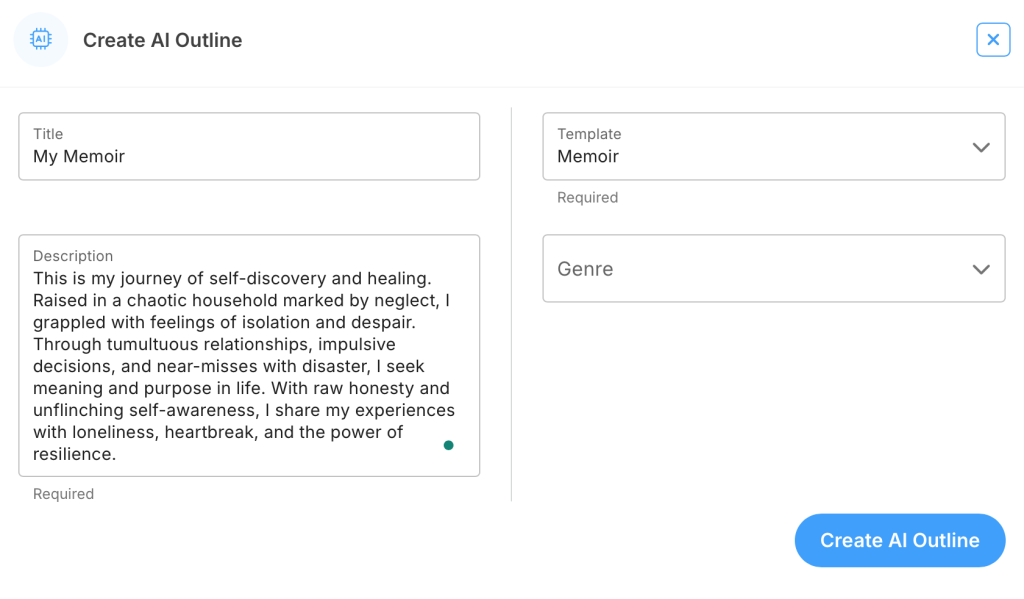
The dropdown “genre” bar allows you to get a little more specific with what theme or sub-genre you’re doing with your story. Here are the options you have:
- Self-Help/Personal Development
- Motivational/Inspirational
- Health & Fitness
- History
- Families & Relationships
- Humor & Entertainment
- Business & Money
- Law & Criminology
- Politics & Social Sciences
- Religion & Spirituality
- Education & Teaching
- Travel
After you’ve picked your genre, you’ll be given a preview of the outline. Here is a look at a preview from my example above, which used the “Families & Relationships” genre:
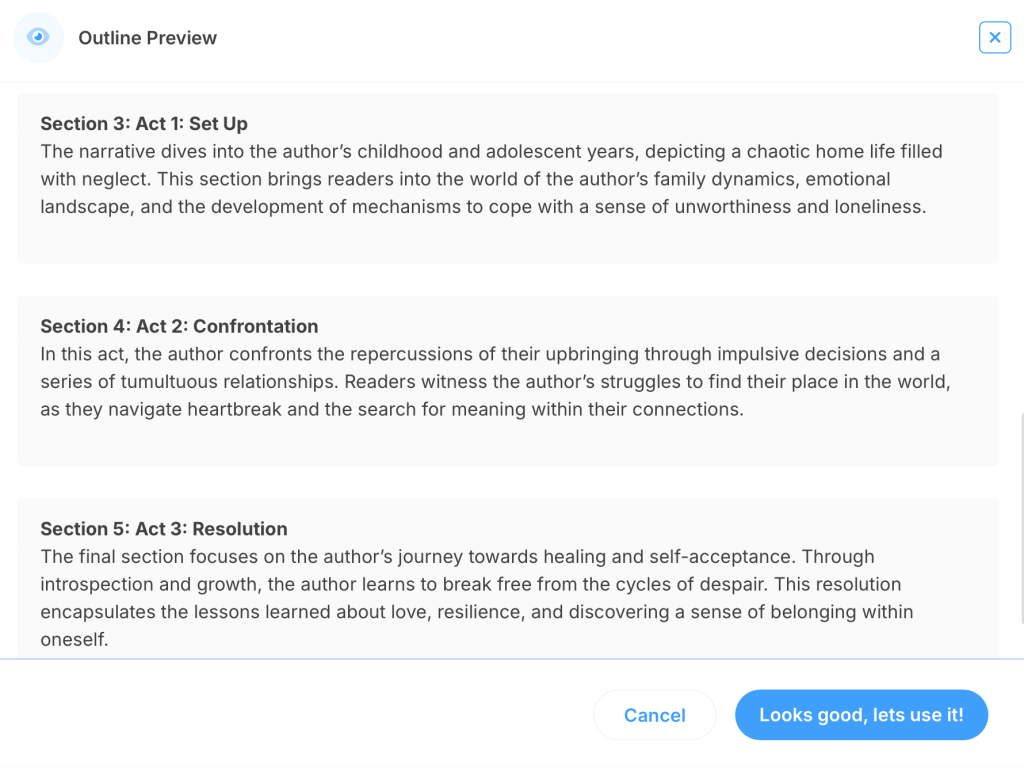
As you can see, the AI outlines provide a lot of additional guidance for what information should go in particular sections of the story. This makes it easier than ever to use high-level story structures within your work without having to overthink things. And best of all, despite being an AI feature, it doesn’t do any of the writing for you.
2. Show, Don’t Tell
We’ve all got that one friend who can tell you about what happened at work that day and tell an entertaining story. Just because your story isn’t fiction doesn’t mean it should be plain. Use descriptive language to paint a picture in the reader’s mind.
You May Also Like: 12 Common Beginner Writing Mistakes You Must Avoid
For example, Instead of saying, “She was very angry,” you could write, “Her face flushed red, and her fists clenched as she slammed the door.” The second sentence shows the character’s anger through her actions and emotions rather than simply telling the reader that she is angry.
Dialogue

When people think dialogue, they think fiction. However, even in a memoir, dialogue can reveal personalities and add depth and authenticity to your story. It can also help to advance the plot and create tension.
What people say and how they say it goes a long way in showing the reader who they are and how they think and feel. It can also advance the story by providing information and fueling conflict without having to information dump readers.
When writing dialogue, it’s important to use natural-sounding language and avoid clichés. I highly suggest you check out my article How To Write Dialogue In A Story for a deep dive into what dialogue is, its purpose in storytelling, and how to do it well.
3. Strong Voice
A memoir, is your experiences, told by you. So, naturally, you’ll want to embrace your voice and style in your writing. If you don’t write often, I suggest just telling the story in whatever way is the most natural. In other words, it shouldn’t be plain, but you don’t want it to be unnaturally flowery or disengenous to yourself.
There is no set, one-size-fits-all voice that you should strive for. Instead, my advice is to be as authentic as you can when telling your story and stick to what you’re doing. In other words, be real and consistent, and your readers will thank you.
4. Conflict And Tension
Building conflict and maintaining tension throughout your story is a critical component of success. In general, this will come down to external conflict (the obstacles you encountered in your life), internal conflict (your internal dilemmas related to those obstacles), and rising stakes.
My favorite way to make sure you’ve done this is through establishing clear “wants” and “needs.” A “want” is what a person wants to achieve throughout the story. This want usually drives the plot of the story from start to finish.
On the other hand, the “need” is the underlying factor that the person needs to navigate in order to get what they want, grow as a person, and be fulfilled. The need will often represent the theme and emotional aspect of the story.
When you consciously have both of these elements present, and your structure/pacing is good, you should have no problem building and keeping a reader’s attention throughout your book.
5. Theme And Message
As mentioned above, once you establish the wants and needs of the main people in your story, you will probably have a good idea of the themes and messages underlying your story. If not, you’ll probably want to ask yourself what messages you want to convey with your story.
Once you do, dig into what audiences the theme would best resonate with and keep them in mind as you write the story. A word of caution, though: avoid being overly preachy and let the theme take form naturally and subtly.
Handling The Sensitive Stuff
Let’s talk about the elephant in the room for many people wanting to write a memoir – People in your family may not like what you have to say. You’re telling your side of the story, and sometimes, that will be very different from what other people remember.
Plus, there’s a good chance you’ll be viewed as giving up all the dirty laundry. What will Grandma, Mom, and Dad think, especially if you paint them in a bad light? There’s also a good chance they may learn things about you (or others) that they didn’t know before.
If you value how they feel or what they think, you probably don’t want them mad at you. So, what do you do? I suggest you write your story as you see it and be truthful. That’s the only way to write. However, after you write it, maybe don’t publish it if it contains things you would rather not have others read.
You May Also Like: How To Get A Book Published: Guide to Agents, Editors & More
The first draft should be 100% your story. But you can write it and see what happens. This removes the pressure of what will happen with your family unit and allows you to write what you need. Perhaps you’ll find that your fears and discomfort were things you’ve been holding onto without cause and feel comfortable publishing after all.
If not, you can always refrain from publishing or even edit certain parts later. However, if you do decide to publish some hard-hitting or accusatory material, I suggest you talk to a lawyer to ensure that your language works and avoid anything that could be considered defamatory or harmful.
Best Books About Memoir Writing

As with any literary genre, books written by experts can be invaluable resources for learning how to write a memoir. Here are five books that cover various aspects of memoir writing. They are:
“The Book You Were Meant to Write” by Kelly Notaras”
Notaras, a writing coach and author, provides a very practical guide to writing a memoir. She offers advice on everything from finding your story to overcoming writer’s block. The book is quite clear concise, and easy to follow and understand. I find her emphasis on finding your unique voice and telling your story with passion is particularly valuable for aspiring memoir writers.
“Your Story” by Joanne Fedler
Joanne Fedler is a writing teacher and coach. Her book, Your Story offers a step-by-step approach to writing a memoir. She covers character development, plot structure, and finding your theme. The structured approach can be helpful for writers who need guidance and support throughout the writing process.
“Shimmering Images” by Lisa Dale Norton
In “Shimmering Images,” Norton talks about the power of imagery and metaphor in memoir writing. She offers practical exercises and advice on using vivid language to bring your story to life. If you struggle to create an immersive and engaging reading experience, you’ll find this a big help.
“Still Writing” by Dani Shapiro
Dani Shapiro is a successful bestselling memoirist who reflects on her journey as a writer and offers advice on overcoming challenges and finding inspiration. Her honesty is an excellent source of motivation for aspiring memoir writers.
Conclusion
There you have it, my friends. Everything you need to know about how to write a memoir. From being sure your life story is good enough to be a memoir, to getting started and the more technical aspects of writing that will make others want to start your book and be unable to put it down.
With LivingWriter outlines and AI tools, there has never been a better time to turn your life story into a book. So, the only thing left to do is sit down, do the “100 moments” exercise, and start writing. Until next time, take care of yourselves, and happy writing.